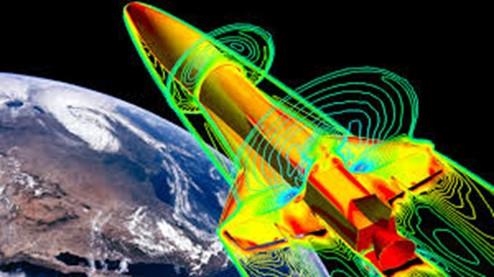Hypersonic Applications: Physical Models for Interdisciplinary Simulation Online
- Updated and expanded course coving the most important topics in Hypersonic Simulation
- All students will receive an AIAA Certificate of Completion at the end of the course
OVERVIEW
Hypersonic numerical simulation developments and improvements are critical to the advancement of current and future sustained high-speed flights and interplanetary explorations. In order to achieve a higher degree of fidelity to the high-enthalpy hypersonic flows, physical models must venture into an interdisciplinary domain by integrating chemical kinetics, ionization, quantum transition, radiation, and electromagnetics with aerodynamics. This unique 12-hour short course is meant to introduce attendants to physical models for interdisciplinary simulation of hypersonic applications, with the emphasis on introduction and evaluation of various physical models and their applications to high-enthalpy hypersonic flows. Topics include internal energy excitations, nonequilibrium chemical kinetics, transport properties (diffusivity, viscosity, and thermal conductivity), energy relaxations, radiative heat transfer, weakly ionized gas, and surface ablation.
Key Topics
- Physical characteristics of high-enthalpy hypersonic flow
- Awareness of hypersonic numerical simulation from a historical perspective
- Internal energy excitations
- Nonequilibrium chemical kinetics
- Transport properties
- Energy relaxations
- Radiative heat transfer
- Weakly ionized gas
- Surface ablation
AUDIENCE
The course is designed for engineers, researchers, students, scientists, and managers interested/ engaged in interdisciplinary simulations of hypersonic applications.
COURSE INFORMATION
Type of Course: Instructor-Led Short Course
Course Level: Fundamentals - Intermediate
Course Length: 2 days
AIAA CEU's available: Yes
This course is also available on-demand. Register here.
COURSE OUTLINE
- Physical characteristics of high-enthalpy hypersonic flow: brief discussions on the characteristics of hypersonic flow with the emphasis on high-temperature effects that distinguished high-enthalpy flow from perfect gas flow
- Awareness of hypersonic numerical simulation from a historical perspective: introduction to hypersonic numerical simulation from a historical perspective with the emphasis on difficulties to develop interdisciplinary models
- Internal energy excitations: introduction to various physical models of internal energy excitations and evaluation of different models
- Non-equilibrium chemical kinetics: introduction to various physical models of non-equilibrium chemical kinetics and evaluation of different models
- Transport properties: introduction to various physical models of transport properties (viscosity, diffusivity, and heat conductivity) and evaluation of different models
- Energy relaxations: introduction to various physical models of energy relaxations and evaluation of different models
- Radiative heat transfer: introduction to various physical models of radiative heat transfer and evaluation of different models
- Weakly ionized gas: introduction to various physical models of weakly ionized gas and evaluation of different models
- Surface ablation: introduction to various physical models of surface ablation and evaluation of different models
Instructed by experts from the AIAA Thermophysics Technical Committee
Chuck Bersbach is a senior principal engineer at Raytheon Missiles and Defense in Tucson Arizona where is a subject matter expert in the areas of aerothermodynamics, ablation/pyrolysis, and other environmental assessments. He is a member of the AIAA Thermophysics Technical Committee since 2016.
Heather Kline is an engineer at Virgin Galactic working in advanced concepts and spacecraft systems. She is a senior member of AIAA and a member of the Thermophysics Technical Committee. Dr. Kline has worked in areas from shape optimization of hypersonic inlets to boundary layer stability under thermochemical nonequilibrium, to high speed civil transport vehicles, to mission control and performance analysis for crewed suborbital spaceflight. She has contributed as a developer to high-fidelity simulation tools including the CFD and multiphysics simulation tool SU2, and the boundary layer stability tool LASTRAC.
Ryan Bond is a member of the CREATE-AV Kestrel Development Team. His employment is carried by the University of Tennessee Space Institute, where he is a Research Professor. He holds bachelor's degrees in Mathematics and Aerospace Engineering from Mississippi State University, an M.S. and Ph.D. in Aerospace Engineering from North Carolina State University, and an M.B.A. from the University of New Mexico. He has prior work experience at Sandia National Laboratories and Arnold Engineering Development Complex.
AIAA Training Links
For information, group discounts,
and private course pricing, contact:
Lisa Le, Education Specialist (lisal@aiaa.org)

